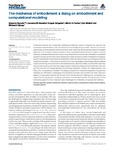The Mechanics of Embodiment: A Dialogue on Embodiment and Computational Modeling
| dc.contributor.author | Pezzulo, G | en |
| dc.contributor.author | Barsalou, LW | en |
| dc.contributor.author | Cangelosi, A | en |
| dc.contributor.author | Fischer, MH | en |
| dc.contributor.author | Spivey, M | en |
| dc.contributor.author | McRae, K | en |
| dc.date.accessioned | 2013-10-15T09:48:17Z | |
| dc.date.available | 2013-10-15T09:48:17Z | |
| dc.date.issued | 2011 | en |
| dc.identifier.issn | 1664-1078 | en |
| dc.identifier.other | 5 | en |
| dc.identifier.uri | http://hdl.handle.net/10026.1/2204 | |
| dc.description.abstract |
Embodied theories are increasingly challenging traditional views of cognition by arguing that conceptual representations that constitute our knowledge are grounded in sensory and motor experiences, and processed at this sensorimotor level, rather than being represented and processed abstractly in an amodal conceptual system. Given the established empirical foundation, and the relatively underspecified theories to date, many researchers are extremely interested in embodied cognition but are clamouring for more mechanistic implementations. What is needed at this stage is a push toward explicit computational models that implement sensory-motor grounding as intrinsic to cognitive processes. In this article, six authors from varying backgrounds and approaches address issues concerning the construction of embodied computational models, and illustrate what they view as the critical current and next steps toward mechanistic theories of embodiment. The first part has the form of a dialogue between two fictional characters: Ernest, the �experimenter�, and Mary, the �computational modeller�. The dialogue consists of an interactive sequence of questions, requests for clarification, challenges, and (tentative) answers, and touches the most important aspects of grounded theories that should inform computational modeling and, conversely, the impact that computational modeling could have on embodied theories. The second part of the article discusses the most important open challenges for embodied computational modelling. | en |
| dc.language.iso | en | en |
| dc.title | The Mechanics of Embodiment: A Dialogue on Embodiment and Computational Modeling | en |
| dc.type | Journal Article | |
| plymouth.volume | 2 | en |
| plymouth.publisher-url | http://www.frontiersin.org/cognition/10.3389/fpsyg.2011.00005/abstract | en |
| plymouth.journal | Frontiers in Psychology | en |
| dc.identifier.doi | 10.3389/fpsyg.2011.00005 | en |
| plymouth.organisational-group | /Plymouth | |
| plymouth.organisational-group | /Plymouth/Faculty of Science and Engineering | |
| plymouth.organisational-group | /Plymouth/Research Groups | |
| plymouth.organisational-group | /Plymouth/Research Groups/Institute of Health and Community | |
| plymouth.organisational-group | /Plymouth/Research Groups/Marine Institute | |
| dc.rights.embargoperiod | Not known | en |
| rioxxterms.versionofrecord | 10.3389/fpsyg.2011.00005 | en |
| rioxxterms.licenseref.uri | http://www.rioxx.net/licenses/all-rights-reserved | en |
| rioxxterms.type | Journal Article/Review | en |
| plymouth.oa-location | http://www.frontiersin.org/Profile/PublicationDetails.aspx?ArtId=2155 | en |


